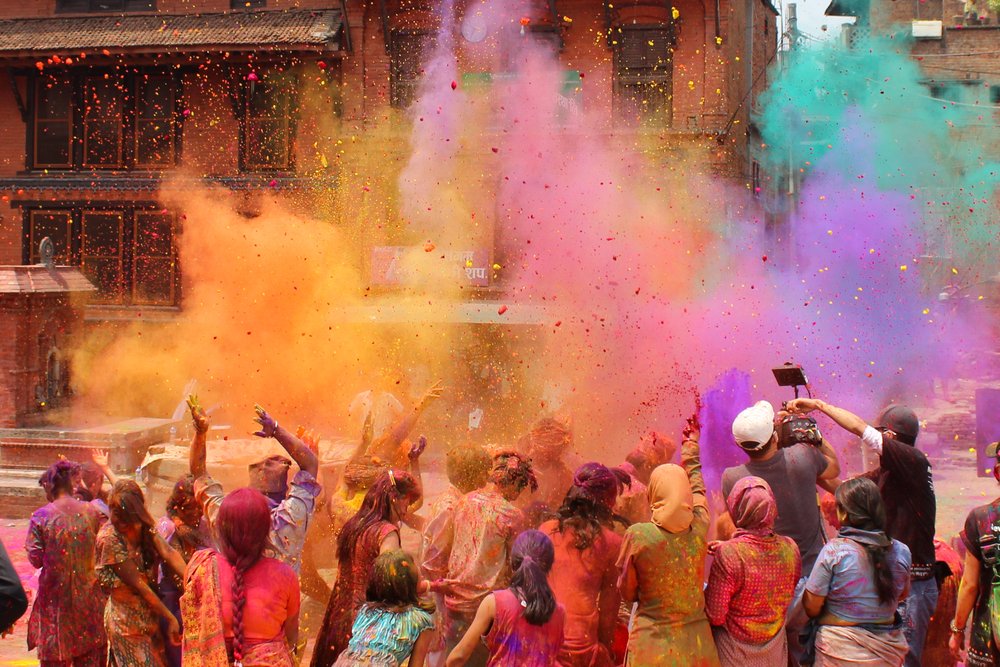Holi The vibrant “Festival of Colors,” offers a rainbow of happiness, music, and traditions that are celebrated throughout India and by Indian communities across the world. Holi is a celebration of the victory of goodness over evil, the arrival of spring, and the strength of friendships. If you’re looking for an authentic and cultural experience, here are the most prestigious locations to experience the beauty of Holi.
Mathura and Vrindavan, Uttar Pradesh:
Considered the birthplace of Lord Krishna, these neighboring towns in Uttar Pradesh are the epicenters of the celebration of Holi. The festivities begin a week before the main day, culminating in grand processions and vibrant colors drenching the streets.
- Dwarkadhish Temple in Mathura: Witness the temple priests shower devotees with colored powder, creating a mesmerizing spectacle.
- Banke Bihari Temple in Vrindavan: Immerse yourself in the week-long “Holi Milan” celebrations, where devotees dance and sing devotional songs while being showered with flowers (Phool Holi) and colors.
Barsana, Uttar Pradesh:
Experience the unique “Lathmar Holi” tradition, where women playfully chase men with sticks, symbolizing the playful love story of Radha and Krishna.
Shantiniketan, West Bengal:
Rabindranath Tagore’s ashram in Shantiniketan hosts a distinctive Holi celebration known as “Basanto Utsav.” This cultural event features traditional Bengali songs, dances, and vibrant processions, offering a glimpse into the region’s rich heritage.
Agra, Uttar Pradesh:
While the Taj Mahal may be the main attraction, Agra also boasts lively Holi celebrations centered around the iconic monument. Witness locals gather in the nearby gardens, throwing colors and spreading the spirit of joy.
Udaipur, Rajasthan:
The “City of Lakes” paints a mesmerizing picture during Holi. Witness the royal family’s grand procession through the city, followed by vibrant celebrations and cultural performances.
Pushkar, Rajasthan:
Combine your Holi experience with a pilgrimage to the holy city of Pushkar. Participate in the traditional “Holi puja” at various temples and enjoy the vibrant colors splashed with enthusiasm in the streets.
Purulia, West Bengal:
Witness the unique “Chhau dance” performances, a UNESCO-recognized Intangible Cultural Heritage, during Holi celebrations in Purulia. These masked dances, depicting mythological stories, add a distinct cultural flavor to the festivities.
Jaipur, Rajasthan:
The “Pink City” transforms into a vibrant canvas during Holi. Witness the spectacular “Elephant Festival,” where elephants adorned in colorful embellishments parade through the streets, followed by exuberant celebrations with music, dance, and colors.
Hampi, Karnataka:
The historical ruins of Hampi come alive during Holi with vibrant celebrations hosted by the local communities. Enjoy the traditional “Manchaha” dance, where performers climb tall poles and shower colors upon the crowd below.
Mumbai and Delhi:
These metropolitan cities offer a diverse and energetic Holi experience. Participate in community-organized events, join street celebrations, or witness the unique “Holika Dahan” ritual, where a bonfire symbolizes the burning of evil.
Beyond the celebrations:
While these locations offer vibrant Holi experiences, remember that Holi is a deeply personal and cultural celebration. Be respectful of local customs and traditions when participating. Dress modestly, avoid throwing colors at hesitant people, and be mindful of the environment using eco-friendly colors.
Holi is much more than throwing color; it is a celebration of inclusiveness, joy, and triumph of goodness over evil. Immersed in the vibrant celebrations will help you gain an appreciation of Indian traditions and make memories that last an entire lifetime.
FAQs:
What is Holi?
Holi, or the Festival of Colors, is an energetic Hindu celebration observed both within India and globally by communities worldwide. Typically, this joyful festival is marked by throwing colored powder (gulal) and water balloons, which symbolize good over evil, spring’s arrival, and strengthening social bonds.
When is Holi celebrated?
Holi is not held on a specific day but takes place each Purnima (full moon) day during Phalguna month, typically March, when its full moon occurs on Purnima Purnima day, normally starting around 3rd March and lasting two days: Holika Dahan involves bonfires and prayers while Rangwali Holi (color play and festivities) takes place the second day (Rangwali Holi).
What are the traditions associated with Holi?
The central tradition of Holi is throwing colored powder (gulal) and water at each other, creating a vibrant and joyful atmosphere. Additionally, bonfires are lit on the first day to symbolize the burning of evil, and people gather for communal singing, dancing, and feasting.
What is the significance of the colors in Holi?
Each color in Holi holds a specific meaning. Red represents love and passion, blue signifies the sky and eternity, green symbolizes new beginnings and spring, yellow reflects happiness and knowledge, and orange depicts fire and energy.
How can I participate in Holi celebrations?
If you’re fortunate enough to be in India during Holi, you can participate by attending local celebrations, wearing old clothes you don’t mind getting stained, and joining the revelry responsibly. However, respecting local customs and traditions and obtaining consent before coloring someone is important.

